Just before lunch, we arrived at the Naabi Holl Gate, the main entrance to Serengeti National Park.
First we saw a solitary hyena near the road.
We soon saw another one in the distance.
And then saw it was a pack of six!
We next stopped at a beautiful rest area for a gourmet lunch and also went for a short hike up a hill to get a view of the area.
 |
| Roast chicken, veggie kabob, and more |
This group of travelers were more interested in their phones (with WiFi reception available) than the beautiful birds.
A small reptile greeted us at the top of our climb.
We saw more superb starlings before heading back out into the park.
Our first big sighting was over 100 zebras spread out near the road, the largest group we had seen in one place.
Then we started to see some big volcanic rocks....and many more. Some have caves under them where leopards hide their babies.
Fitiael told us to look at a distant tree, and with effort we spotted an elusive animal. See if you can spot it in the first picture. It's legs are hanging down from a branch. You may have a better chance in the second photo, and hopefully you will find it in the third! In the latter two, the photo is taken from the reverse direction.
Leopards often take their kill up a tree to avoid another animal stealing it. They often eat gazelles and impalas. Leopard babies at 3 months can climb trees so leopard cubs are safe from lions and hyenas, who kill leopard cubs to reduce competition. The leopard mothers leave their cubs when they are a year to a year and half old.
Then, a bit down the road, we saw four warthogs.
A bit later we saw 6 banded mongoose on termite hill, plus two babies. They eat termites and small reptiles. You can see the two babies in the lower left of the termite hill.
Dark clouds but no rain in the area. It was supposed to begin in another two to three weeks.
Some baboons passed by..
Cute tush?
On the way to our lodging for the next two nights, the Serengeti Sopa Lodge, we saw several Topi. (Several of us missed the luxury tents and the special feeling from being in nature.)
We enjoyed a visit to the cold pool followed by a hot shower, dinner, and bed.
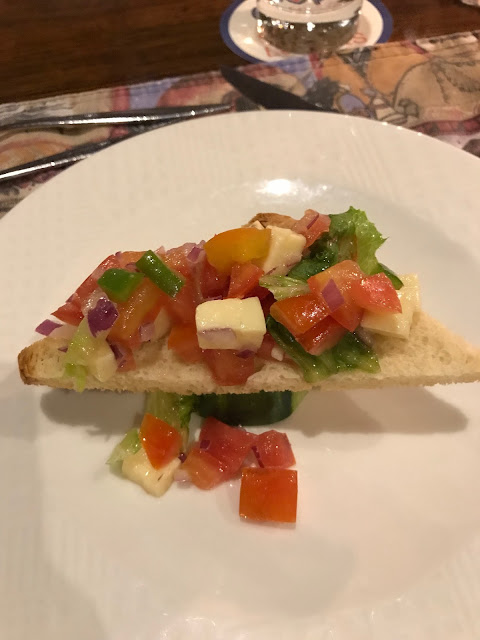 |
| Goat cheese bruschetta |
 |
| A Taste of Tanzania |
 |
| Tropical fruit salad in a chocolate-flavored tulip basket |
Thursday, February 7:
The flowers around the lodge were labeled, including this one.
And this beautiful tree was on the grounds too:
We headed into the Serengeti savanna and first saw an impressive group of male impalas.
We then saw a lion and lioness, almost hidden. They usually would be in a pride, but it is mating season, so they eat and then pair off to mate. They are alone for 3-4 days but they have just eaten and their tummies are full.
Next we saw more than ten water buffalo grazing. They are very aggressive, so our driver/ guide keeps his distance. When lions attack them, they can often defend themselves with their horns and severely injure the lions.
Our next viewing was of Kirks' dik dik with huge eyes, one of the smaller animals in the antelope family. The adult weighs an average of 5 kilos (12 lb.) His eyes look big because of the black around them and then the white to make them stand out more. They were
so-o-o-o very cute!
followed by a small wire-tailed swallow.
This was the day to see hippos--our first sighting was of six or more in a very stinky river. The smell was from their urine, and it was overpowering.
Hippos cannot sweat so they stay in the river during the day to keep cool. The red mucus spots on their backs are protection from the sun. At night they venture out to eat grass, as they are vegetarian. They run fast, but they also are too big to have predators.
.
Next we viewed this Great Crowned crane:
2 more hippos wallowing in shallow water with Grey headed crane behind them.
A Grey backed shrike nearby
And superb starlings at the top of a tall acacia tree. Notice how pointy the thorns are!
We saw 7 zebras close nearby with their heads move up and down as they move. It looks awkward to us but is natural to them.
Hundreds of water buffalo in the distance. Some wallow in mud, so look slimy when the mud dries, Ticks and other insects on their skin suffocate after the mud dries.
A Water buffalo carcass is pictured below. It probably was a solitary, weakened animal so a predator could catch it. Lions killed it and ate their fill and were resting nearby. Vultures also had eaten their fill and are on a nearby tree.
LOTS of water buffalo babies were seen in the large group. They are born brown but between 3-5 months change to black. Two plus hours after birth, the babies can move with their mothers. They don't walk long distances in one day if they have enough to eat and drink. Water buffaloes need drink two to three times a day so have to stay near available water.
They don't consider humans or Land Cruisers a danger to them, but if we were to have gotten out of the vehicles, they could have attacked.
They push-stab with their horns and can kill lions who often kill water buffalo babies.
Cattle egrets and yellow billed or red peckers are on some of the water buffaloes. They help remove insects as they eat. They eat soft green grains,and also are four- chamber rumen animals
We soon found a huge school of hippos, more than 100 in a pond. Black birds on the hippos eats parasites on these huge mammals.
.
Black birds on the hippos eats parasites on these huge mammals.
We stopped for lunch at a beautiful oasis-like area, the Serengetti Visitors/ Center, where we saw hyraxes and yellow spotted barbets. Hyraxes are small vegetarian mammals and are closely related to elephants and manatees. They are definitely not afraid of humans. We were advised not to feed them as they are wild animals and need to fend for their own food.
The yellow-spotted barbets were underfoot but not as close as the hydrax! They were actually brighter than in this photo.
We then went with a walk with a guide-in-training named Noela who took us through the visual history of the area and of the animals who reside here.
First we saw bones of different animals and tried to guess whose they were. I was most fascinated by the giraffe bones. I knew their legs were long, but to see the bone next to Noeli really helped me to understand how long they were....and how heavy!
Part of a giraffe's spinal column:
Below are skulls of different kinds of antelope.
We then walked up their trail, with Noeli explaining parts. Each sign was in Kiswahili and English. The signs were interesting, but you are welcome to skip them and get on with more photos of animals.
Animals that migrate together, wildebeest, zebra, and Thomson's gazelle:
We human animals, climbed the stairs around the path. Notice the animal tracks embedded in the cement.
We also read about President Nyerere's goal to protect Tazania's wildlife and his work with German Bernhard Grzimek, famous for his work on conservation of the Serengeti. Nyerere was a controversial figure internationally but beloved by his countrymen.
We left the center and headed back out in the Serengeti
And saw our first Hartebeest, which is larger than an Impala but smaller than an Eland, and abut the same size as a Topi. All are in the antelope family. But the picture below is a topi.
Notice the bands on the legs.
We also saw a cheetah almost hidden under a tree. Hunting goes by size, so cheetahs do not hunt Topi as they are too big.
FRIDAY, FEBRUARY 8
Our first sighting was of a few giraffes close up with a small impala in the background
Giraffes spent 70% of their lives eating.
Soon we passed a large group of male impalas.
Females are in a harem system with one dominant male and up to 20 females.
A rare sighting for us: a Serval (small spotted cat), which is rare to see during the day as it usually is active at night. It is the size of a mini-cheetah. It has huge ears that stick up and jumped like a kangaroo. It eats small reptiles, guinea fowls, mice, and newborn impalas.
We came upon another example of big volcanic rock, with big cracks and trees growing in them. Big cats like lions and leopards like to give birth here and hide their cubs.
Candelabra trees, which fascinate me, grown among the volcanic rocks.
We saw a Ficus tree in the distance.
We chanced upon an elephant family with several younger ones including a youngster which had no tusks so it might be just three years old.
Tushie photo!
Below you can see a crowd of giraffes of 25 or more relatively close together, where they spread out to eat. It was the largest group of giraffes that we had seen. There were two younger ones on the the main road.
We spotted two lionesses on a huge rock, thanks to Fitiael's great eyesight.
After lunch and before we left Serengeti Park,
We stop to see a tourist bus which is stuck as its steering fluid pipe had broken. They repaired the pipe but needed more fluid. We could not help but Fitiael said that he would notify people at the next place, over an hour away. Meanwhile, they were caught in the hot bus, hoping for help soon.
We traveled down the dirt road, which is the main route for public buses heading from Arusha to the south.
And arrived at El Arai, a Masai village with 120 residents. We paid $50 for the visit directly to the Masal.
The men welcomed us with song and dance.
The women enjoyed watching from the side.
Notice the shoes they wear on their feet. Some are made from recycled tires but others are from cow hide.
Later we four women joined the women in a dance.
They men showed us how they make fire from flint, special branches from the white acacia tree, and stems of the yellow acacia, and mixing the ash with dung to start a larger fire.
You can definitely see the tire tread on the shoe below on the right.
Their homes are made from bamboo poles, with the middle support from the Acacia tree. Mud and dung are used to cover the bamboo. Homes take three weeks to build and are built by the women though the men gather the wood. The homes last for ten years. Cow skins are used for sleeping. They share many things with each other.
 |
| A fenced area for goats, etc. at night |
We divided into two groups, and Helen and I visit a one-family home wither five people slept one three beds. They mainly cook beef, goat or lamb. They drink a lot of cows milk and also milk from sheep and goats. Only the men drink a mix of cow's blood (which they bleed from living animals) and milk. They seem quite healthy and live long lives. The homes are low, so the residents have to bend down to get in and most cannot stand up straight inside as they are tall people. After ages 8 to 10, boys go to sleep in the boy's house and girls to the girls' house. They very much want to preserve their way of life as they also work and study in the outside world.
Below are interesting faces of women. They wear lots of earrings (men wear some too) and necklaces.
And the earlobes can get distended
After leaving their homes, the women had booths set up to sell their wares.
They had very nice bead work. I bought this lion from the woman below, who had made it and paid her directly.
A very serious little girl:
We were shown the separate structures used as bathrooms, bathing, and laundry.
We next went to the classroom for young children through about age 12. Then they go to a high school in the Ngorogoro area. The teacher carried her baby as she taught.
One boy on the left carried his younger sibling..
They learn very basic English and Kiswahili--the alphabet and numbers and a small girl led them in recitation.
Nava tried to talk to the teacher in simple English but was unsuccessful in having a conversation.
After a very enjoyable hour long visit, we headed out to our lodging for the night, the Ngorogoro Sopa Lodge, at 7,800' above sea level.
Below is the path to our room. Unfortunately, we did not have a view of the crater. We were walked to our room after twilight as animals do approach.
This was the view from our room's front door...the lush forest.
Lodge center and pool
Monkey eating discarded apple on ledge near our room.
We left for the crater at about 5 a.m. going down a steep hill to get into it. Giraffes cannot walk down as the path is too steep. We have been very lucky not to have any rain. We went down the west entry by Sopa lodge (where people can exit also) and exited via the east Arai (steep) road, for exiting only.
There are three roads in the crater, and on the way down in the darkness, we saw water buffalo, zebras, and wildebeest.
15 minutes later around a curve
We saw three young lions brothers (about 1.5 years old) with short manes, two about six feet (2 meters) from the road grooming and another a bit farther away. The group is called a coalition.

The solitary brother below
We soon saw a huge group of Egyptian geese, Abdim's storks, and zebras. This protected crater was FILLED with animals!!
We also saw a Kori Bustard, the largest flying bird native to Africa,
and Heartbeests, also known as kongoni, an African antelope.
We soon saw a mother-and-child black rhino in the distance and then another at a much closer distance. Although it is called "black," it is either brown to grey. Black rhinos are solitary animals, not like the the white rhinos in South Africa. As a result, although poaching has almost been eliminated, the black rhinos are not growing in numbers while the white rhinos are. They are fast runners and can travel 35-40 MPH.
The baby is three or four years old, and in a year or two, the mother will leave the baby. This is the closest Fitiael has been to these creatures in months. We watched them quickly trop past zebras and Thomson gazelles.
The black male can weigh up to a thousand kilos while the white male can weigh more than twice that.
Below the two rhinos withe a zebra and gazelle in between and flamingos in the lake in the background:
Until five years ago, Masai grazed their cattle in the Ngorogoro crater, but a new rule forbids combining domestic and wild animals in the same area.
There are two to three big swamp areas in this caldera, and in a very dry season, many wild animals from the upper area come into the caldera..
We soon saw a big, fat hyena lying down close to the road.
And a bit later with saw a jackal with her four cubs in the distance.
The one below was crossing the road just beside us. It was very dusty.
It was calving seasons for both zebras and wildebeests but zebras give birth first so we saw a lot of baby zebras.
A jackal checking out the scene--looking for a vulnerable baby wildebeest.
The zebra below was quite young and still light brown.
This one was so-o-o wide from behind that we thought that she might be very pregnant.
We also saw two male zebras, kicking and biting each other.
A lone warthog passed by.
and lots of baby wildebeests in this area.
A really tiny one below:
A very young lion checking out the scene below:
We stopped at our final rest area before heading back to Arusha. Several hippos were in the water, and we took a nice group picture under a tree. Several of us wandered down the road and were stopped as it was dangerous to wander away from the vans. Oops!
Grey-crowned cranes
Kori Bustard below:
Just out of the crater, we saw Masai girls carrying wood to fix roofs:
We said good bye to Helen (who was heading home) and took one last picture of the three before we headed to the airport and our flight to Zanzibar..
Our ten-day Safari was coming to an end--an unforgettable trip that will remain with us for many years.






















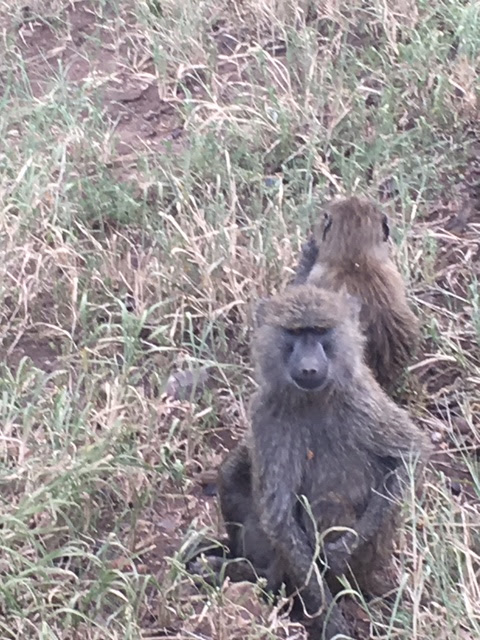





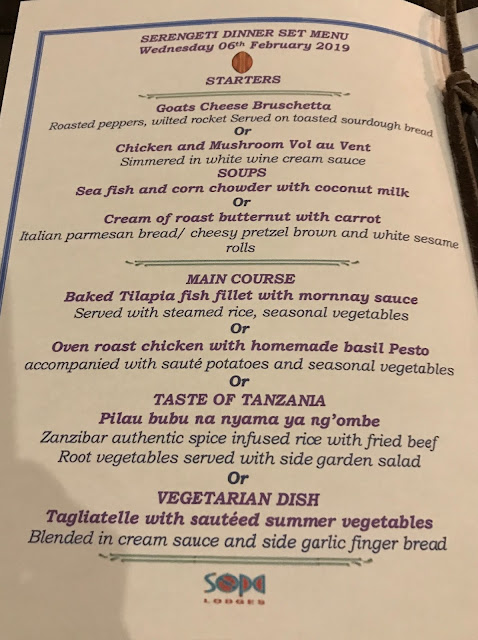











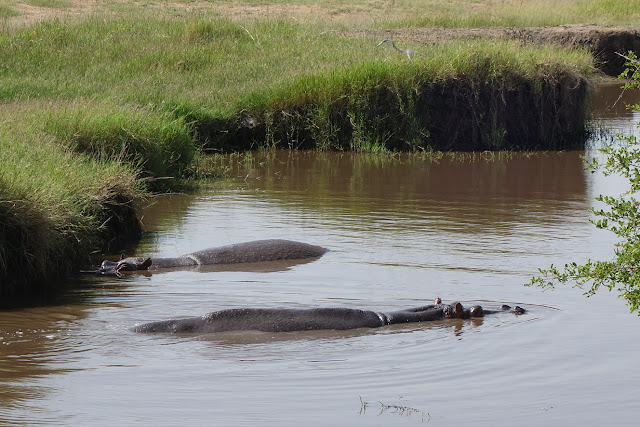









































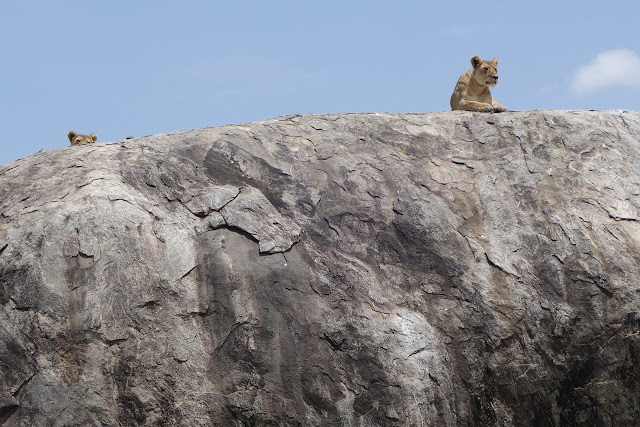




























































2 comments:
I just spent quite a bit of time, vicariously visiting Africa with you (I've only been to North Africa). Your photos are excellent and I am happy to see that pollution and depredation haven't destroyed the animal kingdom, which is at its very best where you were!
Yes, you will have great memories for the rest of your life.
All best wishes, with hopes that you'll come back down here and show your friends around THIS part of the world. I'm ready to help!
hasta la vista?
deet
Great photo documentary and equally wonderful text. For many it would be a trip of the lifetime! I enjoyed seeing all of the wildlife--you got to see so many animals and of so many species. The giraffes have a different type pattern than that seen in most zoo giraffes and they are fascinating. I assume there is no poaching in the locations you visited and that the animals are safe therein.
Post a Comment